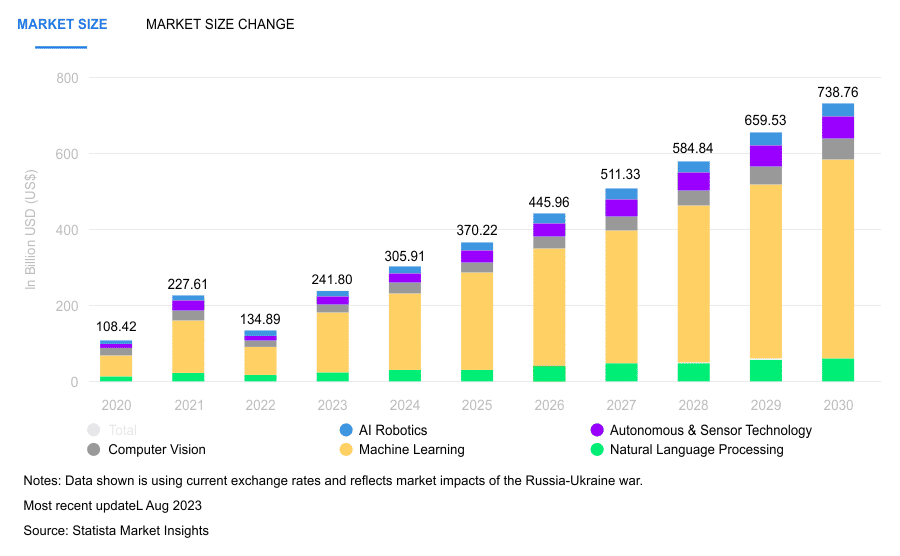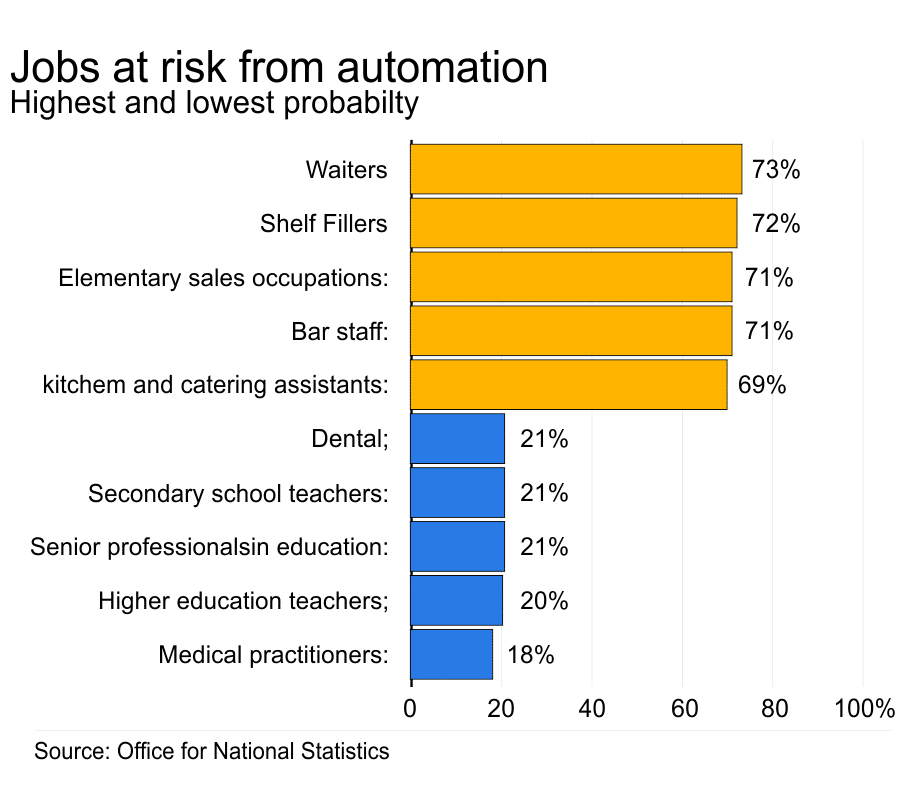
When ChatGPT was launched last year, it became highly trending and the talk of the town. Just within 2 months of its launch, it managed to garner a base of more than 100 million users. Soon, several Generative AI apps started popping out like Bard, Claude 2, Hugging Chat, etc. Not only that we saw image generation apps like Dall-E 2. But as we see AI technology progressing, new AI trends and technologies are emerging rapidly. This article highlights some of the top trends we will be seeing in 2024 and beyond.
AI Industry Outlook

Where is the AI industry heading?
The graph above, sourced from Statista, shows the projected growth of the Artificial Intelligence market size. While it was $108.42 billion in 2020, it is forecasted to surpass $740 billion in 2030. Some research firms including Grand View Research and Markets and Markets have estimated the AI market size to be more than $1.8 trillion as well.
This number highlights the amount of money invested in AI technology and the revenue Artificial Intelligence companies plan to earn. The demand for AI professionals has already started growing and will surge in the coming years. The AI jobs will become more complicated, and these professionals will have to work hard to make up with the latest AI Trends and technologies.
The Latest Trends in the field of Artificial Intelligence in 2024
1. Generative AI beyond texts and images
Now a huge chunk of businesses and individuals be it professionals or students, have started using Generative AI to ease up their tasks. The current Generative AI tools like ChatGPT or Microsoft Bing have become a savior in several tasks that can generate programming codes, do research work, and complete assignments. Businesses leverage their APIs to integrate them into their solutions and automate several things.
But now the research and investment in Generative AI is larger than ever. People can now generate texts, music, and even videos using Generative AI tools. As technology evolves we can see more refinement and accurate generation of these stuffs.
2. Overcoming AI Ethical Challenges
Some of the biggest ethical considerations in the application of Artificial Intelligence are lack of transparency, bias in the output, its effect on replacing humans from their jobs, and their probability of getting out of control. Because of these challenges, the applications of AI are still limited.
But as time progresses we can see AI Leaders formulating strategies and trying to overcome these challenges. Every company wants to incorporate revolutionizing technologies but not at the cost of good ethics.
3. Replacing human begins – AI in customer service

With the advent of AI technology, it became evident that it is going to replace several human jobs. Experts have already evaluated the list of jobs that will be changing into AI jobs. And customer service is the top.
Artificial Intelligence is designed to replace humans with mundane jobs that require no to less creativity and are repetitive in nature. Though some businesses have started using AI in their customer service department, from 2024 we can expect all industries to employ AI to service their customers from telecom to retail to finance. AI Chatbots, virtual assistants, AI AI-synthesized voice messages are some of the trending customer service methods.
4. Augmenting work
When AI tools are getting more advanced, it is not that they will completely replace humans out of their jobs. They are designed to assist humans to speed up their job and with much more accuracy. For example, AI can help write codes, generate business contracts, and prepare scripts for your next YouTube video instantly.
So, using these tools for work augmentation will be a new Artificial Intelligence trend. Are you prepared to use AI in your job?
5. Democratization
Let’s learn from ChatGPT itself, what democratization means.

So, by the year 2024, we will be seeing widespread use of AI in business as well as individual capacity.
6. No code software engineering
In 2019, Gartner made a forecast that by 2024, approximately 65 percent of application development would be done via low-code/no-code tools, and this prediction is likely to come true because of the emergence of generative AI tools like ChatGPT. These tools enable individuals to swiftly create and test applications. While we do not anticipate coding and software engineering roles disappearing by 2024 (as there's still a need to develop the AI tools themselves), there will be numerous exciting prospects for individuals with creative ideas and a passion for problem-solving, even if they lack extensive technical skills.
7. Rise in AI jobs

Now that AI is poised to replace humans on the job, what will be humans doing? Well, according to a report by the World Economic Forum titled "The Future of Jobs Report 2020," AI is expected to replace 85 million jobs worldwide by 2025. However, the report goes on to say that it will also create 97 million new jobs in that same timeframe. This means that AI is expected to create a net increase of 12 million jobs by 2025. A 2023 report by McKinsey & Company found that AI could create up to 77 million new jobs in the global economy by 2030.
So it’s high time that you embrace the AI job trends and become future-ready with the best Artificial Intelligence certification programs.
8. Healthcare revolution
Artificial intelligence (AI) is transforming healthcare in several ways, such as enhancing diagnosis and treatment by analyzing extensive medical data, boosting drug discovery, improving patient care through remote monitoring and personalized advice, and reducing costs by automating tasks and optimizing processes.
Specific applications of AI in healthcare include more accurate cancer detection in medical images, personalized cancer treatment plans, drug development, remote vital sign monitoring, and task automation. While AI is still evolving in healthcare, in the future it holds immense potential to revolutionize the industry and enhance patient outcomes.
Conclusion
Artificial Intelligence is at its infant stage but growing rapidly. The development we have seen in the last few years in the field of Artificial Intelligence surpasses all the technical advancements done in the last few decades. With AI getting smarter day by day, they will be assisting in the development of even smarter technology. These AI trends are surely to watch out for. And time will tell how humans will co-exist with highly evolved Artificial Intelligence. Let’s wait and watch.
Follow us: